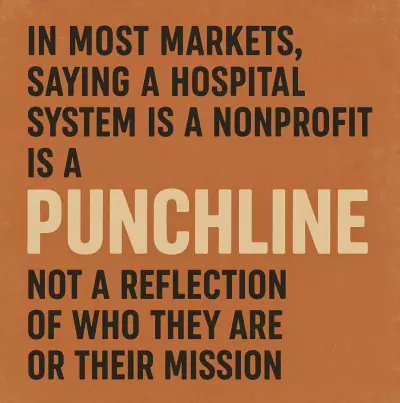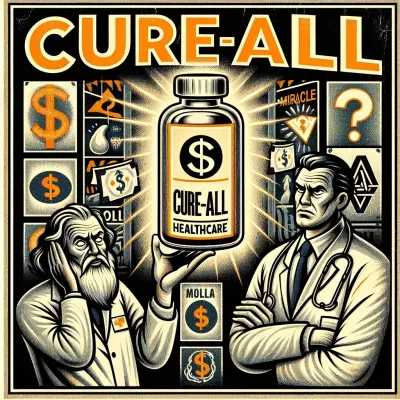Postindustrial Healthcare Columnist Mike Stancil pulls no punches when examining what’s wrong with the for-profit healthcare system in America.

Let’s start by answering an important question:
What is a “public benefit corporation?”
Since Delaware is the state of choice for the founding of most companies, we’ll use their definition:
A for-profit corporation that is intended to produce a public benefit or benefits and to operate in a responsible and sustainable manner.
In following this definition, an organization that wants to be a public benefit corporation (PBC) must make sure that its public benefit is clearly stated and approved by the organization’s shareholders and filed with the state.
There is a legal requirement that profits be balanced against the organization’s stated mission. The balance between public benefit and profit decision-making must also be reported at least biennially.
Now, let’s address the nonprofit elephant in the room.

Why nonprofits can’t be trusted in healthcare services
In most markets, saying a hospital system is a nonprofit is a punchline, not a reflection of who they are or their mission.
I won’t go into detail about why they all became nonprofits. But I surmise that it has more to do with most legacy hospitals being founded by religious organizations than with launching massive facilities without a focus on profit.
There’s also something inherently distasteful about providing life-saving services for profit. Even in the most free-market thought exercises, the idea sits in an uncomfortable place where poverty or wealth somehow decides your quality of care.
Who could imagine such a horrible, unfathomable reality such as that?
Let’s move on from speculating on why a “nonprofit.” I think most people would expect most essential things in healthcare to be nonprofit. It just seems to be the way things are.
Of course, that’s not the only case. Many of the biggest players in our healthcare world are unapologetically for-profit (more on this later.) But we have billion-dollar organizations that own multiple health systems and insurance products that are still nonprofits.
Yep, that’s the punchline.
The problem with nonprofits is that they must put any revenue back into their mission. That’s pretty much the crux of it. And with armies of lawyers and accountants willing to take some of that money, they’ve found creative ways to “not make a profit.”
We also have a problem with inefficiency. Unlike the for-profit world, where reduced costs and optimization lead to more profit for the shareholders, nonprofits are punished for being overly efficient.
I remember being at a private university as the fiscal year was drawing to a close, and our department had not spent its entire budget. Knowing that the budget would be reduced if it wasn’t fully accounted for, the head of the department asked everyone for a wish list so that we could create a flurry of purchases to justify the budget—or maybe ask for more. That year, I got a new drone for the marketing department.
This is happening everywhere in the nonprofit world.
In healthcare, instead of drones, health systems are buying independent hospitals, land, or entire production companies.
The sociopathy of the free market
So, if we want efficiency, why aren’t we pursuing a system that emphasizes efficiency and competition within our consumer economy? The simple answer is that healthcare’s first principle is the health of people and free market consumer capitalism does not care about people.
That doesn’t mean it’s terrible – to be clear. It just means that at the foundational level, a for-profit company sees everything as assets and liabilities and acts accordingly. Sure, an empathetic boss or a company with a truly people-focused work culture may steer close to genuinely valuing the people there. But realistically, keeping with the idea of sociopathy, it’s just a mask to attract a certain type of person to a certain type of job. When the company’s success is on the line, the people will be discarded before the company.
Again, this isn’t a value judgment. It’s the cold efficiency of the market—but cold efficiency is immediately at odds with something like healthcare, where the first principle is the well-being of people. Eventually, no matter the starting point, the company will have to make a decision that pits additional profits over what’s best for the patient.
Let’s imagine a new healthcare tech company entering the market. The founder is extremely mission-driven. Maybe the company is a cancer-care tech company, and the founder lost someone or is caring for someone they love with cancer.
It’s a successful company with great market viability. It quickly grows and dominates its market. As it matures, the company introduces new iterations of technology, optimizes processes that were old relics from the startup days, and shifts its focus to additional value propositions to keep profits coming in and shareholders happy.
Now, it’s a fully mature company. Its growth has largely stagnated as it reaches market saturation. Next-generation tech companies are now emerging and challenging the companies standing in the market. That means a lot of its revenue needs to go back into R&D and investment in its sales and accounts teams. The founder is now looking for ways to meet profit goals year over year in a saturated market that no longer offers obvious paths to increased profitability.
That’s when it was brought to his attention that certain underperforming markets were taking up a disproportionate number of resources. Rural areas have a high number of individuals with cancer, but they are low-income and not centralized, so the logistics and sales support offset any revenue and are actually operating at a loss.
It’s obvious what he needs to do. His only duty is to the shareholders – it’s not personal or done with any malicious intent.
Rather, it’s the sociopathy of the market.
This is just one easy-to-describe example. The reality is that most of the decisions are small and go unnoticed but ultimately have a cumulative impact that is next to impossible to fix without completely starting again (see the legacy PBM market).

Is there a panacea?
No. At least not in my opinion.
In fact, I think a good rule of thumb is that if anyone ever pitches something as a cure-all, they are not to be trusted.
No single idea is incorruptible. When nonprofits were established, it was a distinction that was supposed to mean something. So, I’m not naïve enough to believe that a good idea can’t eventually go bad.
However, I do believe that this is a step in the right direction. Iteration is the path to better solutions.
All healthcare solutions should be public benefit corporations
So, now we return to the thesis.
You’ll notice that I used the word “should.” This is intentional because I recognize that not all healthcare solutions can be public benefit corporations. This is driven by the fact that in order for a company to be a PBC, 100% of the shareholders need to approve the PBC designation and mission. Unfortunately, that just can’t or won’t happen in many places within our healthcare market.
The argument is that we should strive to make it the majority approach – certainly for new companies entering the market. Hopefully, the rationale – or at least my rationale – is apparent through my critiques of traditional nonprofit and for-profit approaches.
The inelegant summary is that nonprofits are inefficient and have betrayed their designation, while for-profits sacrifice their mission and impact for efficiency and profit.
The PBC splits the difference, celebrating and rewarding efficiency and innovation through profit, but with guidelines in place to ensure that decisions are not made at the expense of the public benefit.
Will those guide rails catch everything? Absolutely not. Decisions are made every day with no clarity over what is ultimately right or wrong. There are issues that have nuance and depth that can’t simply be measured as good or bad for the mission but nonetheless must be made.
The PBC creates a new iteration of a company that champions mission as the priority and profits as a nearly equal second priority.
It elevates the consideration of impact, which in healthcare is ultimately quantified by lives saved or quality of life improved, to be at least as equal to and hopefully marginally higher than profit. The stakes in healthcare are immediate and self-evidently important. There isn’t some hand-wavy broad-concept mission that can be dismissed when it comes to healthcare—at least for now.
So, the question is, “Why aren’t more healthcare companies entering the market as public benefit corporations?” I understand why incumbent companies aren’t. That’s a nearly impossible ship to turn around.
But if you’re starting out and have the mission to bring real, lasting change and impact to people through healthcare, why would you not take steps to put the guiderails on and protect that mission?
I believe the companies that do this will become the vanguard of the new healthcare market in the United States.







